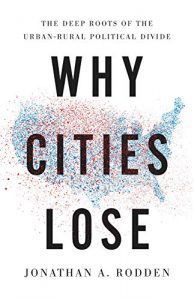Jonathan A. Rodden at Edge:
 Over the last decade, I’ve been asking myself a couple of closely related questions. First, what explains the incredible growth in what we might call urban-rural polarization? What explains the fact that voting behavior has become so highly correlated with population density over time? This is something that’s happened not just in the United States, but also in a number of other industrialized countries. Secondly, what are the implications of this polarization for who wins and loses and whose policy agenda gets put into place?
Over the last decade, I’ve been asking myself a couple of closely related questions. First, what explains the incredible growth in what we might call urban-rural polarization? What explains the fact that voting behavior has become so highly correlated with population density over time? This is something that’s happened not just in the United States, but also in a number of other industrialized countries. Secondly, what are the implications of this polarization for who wins and loses and whose policy agenda gets put into place?
In a political system like the United States, or Great Britain, or any of the countries that were colonized by Great Britain—including Australia, Canada and, for most of the postwar period, New Zealand—we draw single-member districts, and the way we form a legislature is by electing one individual from each of those districts. When we divide the world in that way, we end up concentrating voters for the urban parties of the left in urban districts, and end up with more dispersed support for the parties of the right elsewhere. This creates an important pattern in the transformation of votes to seats that has existed throughout the postwar period. It affects who gets represented and whose policies end up as law. In politics, geography matters in a way that we’ve been somewhat aware of for a long time, but all of these factors have become much more important over time, especially in the United States.
More here.
